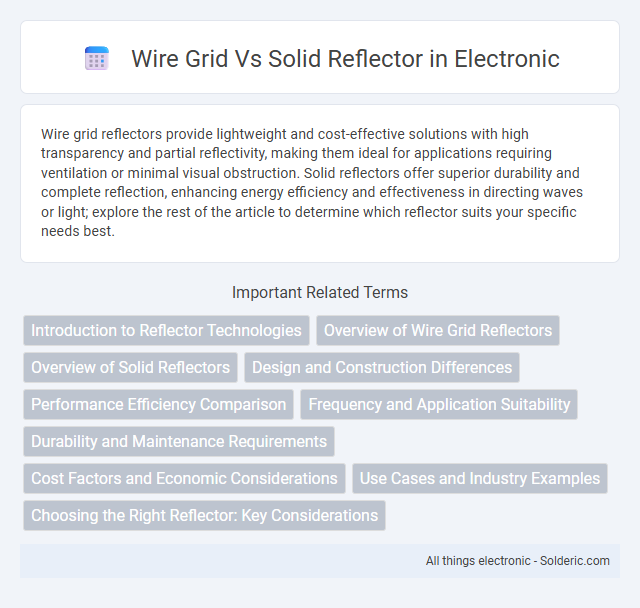Wire grid reflectors provide lightweight and cost-effective solutions with high transparency and partial reflectivity, making them ideal for applications requiring ventilation or minimal visual obstruction. Solid reflectors offer superior durability and complete reflection, enhancing energy efficiency and effectiveness in directing waves or light; explore the rest of the article to determine which reflector suits your specific needs best.
Comparison Table
| Feature | Wire Grid Reflector | Solid Reflector |
|---|---|---|
| Material | Metallic wires arranged in grid pattern | Continuous solid metallic surface |
| Weight | Lightweight | Heavier |
| Wind Resistance | High (better airflow) | Low (high wind load) |
| Reflectivity | Moderate to high | High (better signal strength) |
| Cost | Lower manufacturing cost | Higher manufacturing cost |
| Durability | Corrosion prone, requires maintenance | More durable, less maintenance |
| Applications | Satellite dishes, radar antennas where weight and wind resistance matter | High-gain antennas, broadcasting where max reflectivity needed |
Introduction to Reflector Technologies
Wire grid and solid reflectors represent two fundamental technologies in reflector design, each serving distinct applications based on electromagnetic properties. Wire grid reflectors utilize finely spaced conductive wires to reflect specific wavelengths, offering lightweight, frequency-selective performance ideal for antennas and filters. Solid reflectors, composed of continuous metal surfaces, provide broadband reflection with high efficiency, commonly employed in satellite dishes and radio telescopes for maximum signal gain.
Overview of Wire Grid Reflectors
Wire grid reflectors consist of closely spaced parallel wires that reflect electromagnetic waves by inducing surface currents, offering high reflectivity with reduced weight compared to solid reflectors. These reflectors provide improved airflow and decreased wind load, making them ideal for large-scale antenna arrays and radar systems. Your choice between wire grid and solid reflectors depends on application-specific requirements such as structural weight, operating frequency, and environmental conditions.
Overview of Solid Reflectors
Solid reflectors consist of continuous, opaque surfaces that effectively redirect electromagnetic waves by reflecting nearly all incident energy. Their high reflectivity and minimal transmission make them ideal for applications requiring strong signal control and minimal loss, such as radar systems and satellite communication. Compared to wire grids, solid reflectors provide superior performance in blocking unwanted signals and enhancing directional gain.
Design and Construction Differences
Wire grid reflectors consist of thin, evenly spaced conductive wires arranged to reflect specific electromagnetic wavelengths, offering lightweight and flexible design advantages. Solid reflectors are constructed from continuous metallic surfaces, providing broad-spectrum reflection with higher durability and structural rigidity. The choice between wire grid and solid reflectors depends on performance requirements, frequency range, and mechanical constraints in applications like satellite antennas and radar systems.
Performance Efficiency Comparison
Wire grid reflectors offer improved performance efficiency in high-frequency applications by reducing weight and minimizing signal attenuation compared to solid reflectors. Solid reflectors provide superior reflectivity and durability in lower-frequency ranges, ensuring consistent energy reflection with minimal loss. Optimizing reflector choice depends on frequency range, environmental conditions, and desired signal fidelity.
Frequency and Application Suitability
Wire grid reflectors excel at higher microwave and millimeter-wave frequencies due to their selective polarization and low-loss characteristics, making them ideal for radar and communication systems requiring lightweight components. Solid reflectors perform better at lower frequencies and applications demanding high power handling and structural robustness, such as satellite dishes and radio telescopes. Frequency-dependent efficiency and installation environment heavily influence the choice between wire grid and solid reflector technologies.
Durability and Maintenance Requirements
Wire grid reflectors typically offer greater durability due to their open structure, which reduces wind resistance and lessens the risk of damage during harsh weather conditions. Solid reflectors, while providing higher reflectivity, require more frequent maintenance to prevent surface degradation from environmental factors such as dirt, corrosion, and UV exposure. Choosing a wire grid reflector can lower your maintenance efforts and extend the lifespan of your equipment in demanding outdoor applications.
Cost Factors and Economic Considerations
Wire grid reflectors typically offer lower material costs due to reduced metal usage compared to solid reflectors, making them more economical for large-scale applications. Manufacturing expenses also tend to be lower because wire grids require less processing and weigh less, reducing transportation and installation costs. However, solid reflectors may provide better durability and performance, potentially lowering long-term maintenance expenses despite higher initial investment.
Use Cases and Industry Examples
Wire grids excel in applications requiring polarization control and microwave frequency filtering, commonly used in telecommunications and radar systems. Solid reflectors are preferred in solar energy industries and satellite communications for their high reflectivity and durability under harsh environmental conditions. Your choice depends on the specific electromagnetic properties and operational environment essential to your project requirements.
Choosing the Right Reflector: Key Considerations
When choosing the right reflector, consider the wire grid reflector's ability to reduce weight and improve airflow, making it ideal for applications requiring heat dissipation. Solid reflectors provide superior durability and enhanced light control, ensuring consistent and focused reflection in your lighting setup. Your choice should balance the need for thermal management against desired reflectivity and structural strength.
wire grid vs solid reflector Infographic

 solderic.com
solderic.com